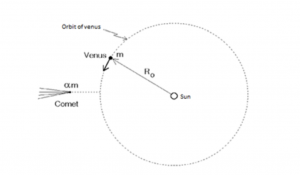2021年IOAA理论第14题-金星2号的形成
英文题目
A comet of mass $$\alpha m$$ is heading ("falls") radially towards the Sun. It is known that the total mechanical energy of the comet is zero. The comet crashes into Venus, whose mass is $$𝑚$$. We further assume that the orbit of Venus, before the collision, is circular with radius $$R_{0}$$ . After the crash, the comet and Venus form a single object, called “Venus-2”.
14.1 Find the expression in terms of $$M_{sun}$$ and $$R_{0}$$ for the orbital speed, $$\upsilon _{0}$$ , of Venus before the collision.(1.0pt)
14.2 Find an expression for the total mechanical energy of Venus in its orbit before colliding with the comet.(1.0pt)
14.3 Find an expression for the radial velocity, $$\upsilon _{r}$$ , the angular momentum, $$𝐿$$ , of "Venus-2" immediately after the collision.(10.0pt)
14.4 Find an expression for the mechanical energy of the combined object “Venus-2" and express it in terms of energy before the collision,$$E_{i}$$,, and $$\alpha $$.(5.0pt)
14.5 Show that the post-collision orbit of “Venus-2” is elliptical and determine the semi-major axis of the orbit.(5.0pt)
14.6 Determine if the year for the inhabitants of “Venus-2” has been shortened or lengthened because of collision with the comet. Write the ratio between the period of Venus-2 and Venus.(3.0pt)
14.7 What should be the value of $$\alpha $$ such that the post-collision orbit of Venus-2 would make it crash in the Sun? We will call this as $$\alpha _{c} $$.(5.0pt)
14.8 A comet with $$\alpha=\alpha _{c}$$ collided with Venus. Calculate the percentage change in the magnitude of Venus’ velocity $$\left ( \delta \phi \right ) $$ and the change in the direction of the velocity vector $$\left ( \delta\theta\right ) $$ immediately after the collision.(5.0pt)
